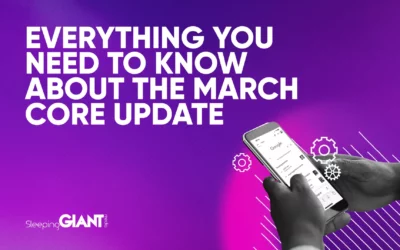
How to Grow Your Digital Prestige With Social Media
Louis Vuitton currently reigns supreme among the luxury goods brands on social media, with a cross-channel following of 102M (Feb 2024) and an average cross-channel engagement of 66.7k per post.
From their brand collaboration with sensational K-pop boy band, BTS, to their viral TikTok videos, Louis Vuitton enjoys a comfortable position in that sweet spot between widespread popularity and exclusivity. But how?
In this blog, we’ll explore how luxury brands use social media to maintain digital prestige, while simultaneously extending their reach and maximising their engagement online.
The strategy behind digital prestige
The customer base for the luxury goods market is expected to hit 500M by 2030, an impressive amount for any sector — let alone one that prides itself on exclusivity and rarity.
And just like that, we’ve touched on the central conundrum for luxury goods marketers: cultivating a sense of exclusivity while still maximising reach. The famous ‘4 E’s’ of luxury marketing, coined by expert, Michel Chevalier, hold this conundrum at their centre:
- Emotions: Luxury brands should create a sense of desire and/or aspiration.
- Experiences: Through tactics such as immersive shopping experiences or events, luxury brands should offer value beyond their products or services.
- Extension: Luxury brands should interact with buyers beyond their products and services through things like influencer collaborations and features
And, lastly:
- Exclusivity: Customers investing in luxury brands should feel like part of an exclusive club.
Uniquely, the goal of exclusivity sits at odds with the typical, core objectives of any marketing strategy — visibility, widespread reach, maximum exposure, and engagement.
So, marketers in the luxury goods industry have to deploy much more sophisticated strategies — leaning on audience targeting, core messaging, and brand storytelling — if they want to reach the masses, but engage the select few, high-net-worth individuals (HNWI). The most effective way to do this? Social media.
Using social media to generate digital prestige
85% of luxury consumers use social media regularly – each using an average of three platforms. So, consider the outdated myth that true luxury marketing is purely an off-line activity to be well and truly debunked.
Using an effective combination of the following social strategies, luxury brands in all niches — from fashion to technology — have been growing their digital prestige. And, using examples, we’ll show you how you can too.
Influencer collaborations & user-generated content
Authenticity and representation are increasingly important values that consumers are demanding from brands. Products being used and reviewed by trusted individuals is an essential part of marketing now. In fact, 92% of people trust recommendations over a brand.
With this in mind, we see user-generated content becoming an indispensable tool for luxury brands to increase the desirability and perceived popularity of their products.
Collaboration in action
Studies have shown that the Asia-Pacific region is the top market for luxury brands. So, the recent trend of numerous brand partnerships with K-pop stars makes sense — especially when it comes to engaging Millennials, Gen-Z, and Gen Alpha (expected to make up 80% of luxury product consumers by 2030).
One of the most effective examples of this in action is Louis Vuitton’s influencer partnership with BTS member, J-Hope. After this announcement, they saw a staggering 10.7% engagement rate increase from their followers.
Identifying and partnering with influential figures that compliment your brand, perhaps themselves embodying values such as elegance and poise, is an excellent way to elevate your prestige while benefiting from the increased visibility that comes with such a public partnership.
Campaigns to promote prestige
An often overlooked aspect of cultivating exclusivity and a luxury brand is the product or service itself — nothing works as a selling point quite like physical, tangible scarceness. Limited edition products, exclusive events, personalised services, and limited-time offers are excellent ways to further cultivate a sense of exclusivity.
As for translating this onto social media, campaign messaging should be tailored to this approach using phrasing that conveys luxury and limited availability — similar to the tone of voice in remarketing ad copies, with an emphasis on the fleeting nature of the products or services on offer. More on this later.
Nuanced audience targeting
When it comes to paid social media advertising, luxury brands have their work cut out — accurately identifying buyer personas and then translating these into effective audience targeting strategies. Beyond mere demographics, psychographics are needed here too, taking into account shopping habits, values, and aspirations.
Taking Facebook as an example, there’s a versatile range of ad targeting options available to luxury brands looking to engage a distinct segment of users.
Let’s say you sell luxury watches. You could create a custom saved audience that allows you to target individuals of a certain age, with a certain household income (this is possible for US-based audiences only at the moment), and with interests in luxury goods like watches.
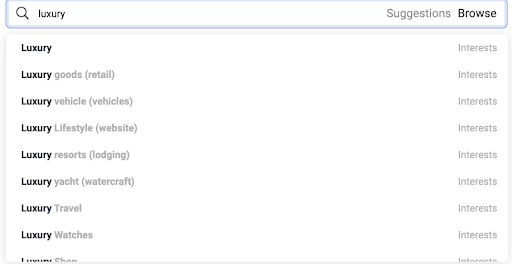
If you want to get really granular, you can exclude certain interests that pertain to lower-expense activity. For example, luxury, high-end travel agents could exclude interests such as cheap tickets or flights.
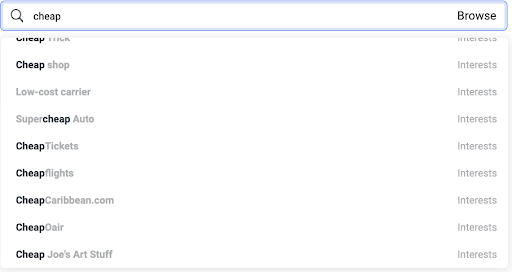
Communicating prestige with organic social media
Circling back to messaging, when creating assets and copy for your ads (and any social media posts for that matter), prestige has to shine through there too.
The luxury feel of your brand has to be communicated to your audiences at all levels and touchpoints — from the words and emojis you use in captions to the images you post on the grid. So, investing heavily in quality copywriters and adhering to strict style guidelines is a must here.
Breaking this down into its components:
Tone of voice & content topic
It is estimated that nearly a third of global luxury sales will take place online by 2025. So, viewing online users as viable bottom-of-the-funnel audiences (and marketing to them accordingly) is essential. That being said, sales-focused content should always be diluted with a tasteful steam of ‘lifestyle’ content — more so than in any other market group.
Most luxury advertising shouldn’t be to inspire direct conversion. Instead, it’s about showcasing a lifestyle, or the feelings associated with it, that consumers and HNWIs can buy into. A great example of this is those lengthy, lavish perfume, aftershave, or car adverts that feature the product briefly against vignettes showing a certain type of elevated lifestyle.
Convey luxury through imagery
It goes without saying that the imagery associated with your brand should betray the value of its products and services.
Image quality cannot be compromised — especially for physical products. Take Rolex, for example. They have an iconic product that speaks for itself, and their Instagram feed clearly lets it do the talking. Non-cluttered images with simple backgrounds that showcase the product on offer work seamlessly here.
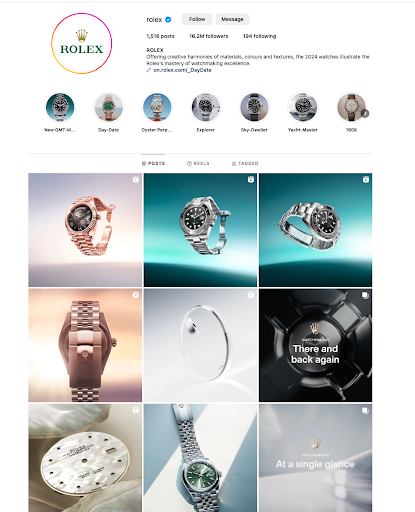
Video content
Rolex has also perfected utilising video content on social media to showcase the lifestyle their target market could have if they buy into the brand.
Rolex has been using YouTube to share videos with a high production value to evidence the luxury lifestyle they embody. This includes short, dramatic clips or montages of golfing, skiing, and orchestral pieces. Cleverly, alongside this content, they also share general how-to videos that people who already own Rolexes will find helpful.
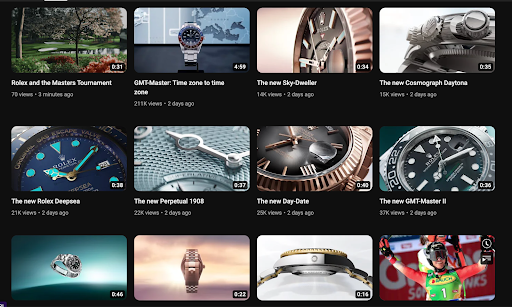
TikTok
A social media platform previously untapped by luxury goods businesses, TikTok is often ‘slept on’ by luxury brands. Why? Partly due to the example term we just used.
- TikTok’s informal, accessible nature is often perceived to be at odds with the polished, exclusive image that many luxury brands are going for,
- On the other hand, TikTok’s many trends and terms can also be tricky terrain for an established brand to navigate — leaving it, well, slept on.
In fact, it has been estimated that only half of the brands in this landscape actively post to TikTok. This is fascinating when considering that this is the platform where brands have largely generated the highest engagement rates.
However, according to recent research, younger generations are not only predicted to make up the large majority of luxury markets by 2030, but Gen-Z, the largest age demographic of TikTok users, are buying luxury items three to five years earlier than Millennials. With this shift in luxury goods purchasing habits, brands cannot afford to ‘sleep on’ this platform for much longer.
As a side note – just because you’re posting on TikTok, doesn’t mean you have to compromise on core brand values like quality, elegance, and poise. Take Versace, for example:
- Versace has one of the highest engagement rates of luxury fashion brands on TikTok at 7.98%. How? They lean heavily into a few popular trends — using brand ambassadors and posting video footage of fashion shows.
- However, they’ve maintained their digital prestige by not stooping to common or irrelevant trends, and consistently posting exceptionally high-quality video content with sharp, crisp shots. This lets their audience know that, while they’re relevant, they’re still high quality.
Storytelling
As much as it is worth letting the products do the talking, this only works if founded upon a solid foundation of brand storytelling. While not every brand will have a mythical origin story like Cartier or Chanel, much of the perceived value of luxury goods is bound up in their creation, how they came to be, and their founding.
So, using social media to give voice to the history of your brand and its vision, values, and mission — especially connecting to strong concepts like heritage, sustainability, and innovation — works well.
Staying selectively exclusive with social …
Putting that all together, luxury brands have to navigate modern social media trends and be seen to be ‘in touch’ with modern audiences, while still maintaining that desirable, cool ‘aloofness’ synonymous with luxury itself.
They must fine-tune their audience targeting strategy and complement it with well-placed, consistent organic activity — taking into account asset quality, and even emoji usage. They should also extend their brand beyond their own efforts, with influencer partnerships and collaborations, while maintaining absolute control over their perceived value online.
To say it’s a bit of an art would be an understatement. But that means there’s room for savvy players to stand out from the crowd.
If you’re looking to better leverage social media to grow your digital prestige as a luxury brand, get in touch with our team of experts today.
Or, head to our events page to see our upcoming marketing how-to sessions and webinars. In the meantime, you can read more about the benefits of a reactive social media strategy on our blog.
Why not check out our webinar?
Integrating AI Whilst Maintaining The Human Touch
Blog
Everything you Need to Know About the March Core Update
We knew it wouldn’t be long before Google released their first core update of...
Giant Wednesday
How To Optimise Images For Websites
Digital Marketing, technology & business insights, how-to's and explainer...



